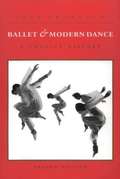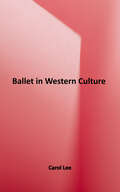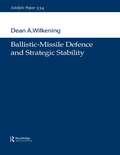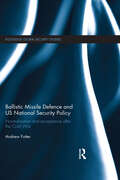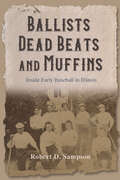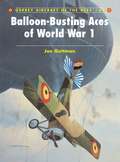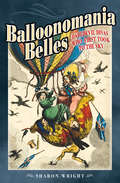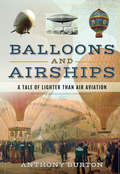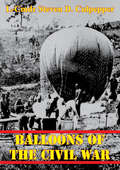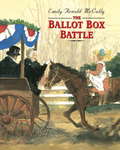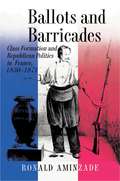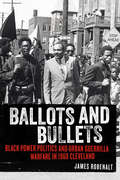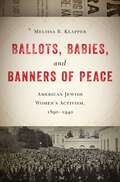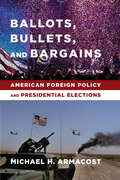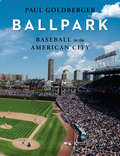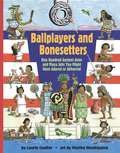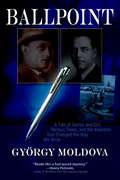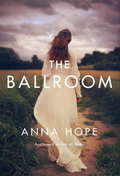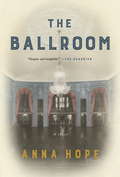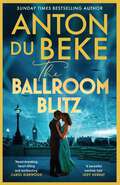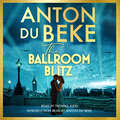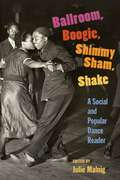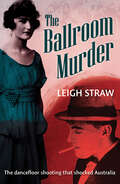- Table View
- List View
Ballet and Modern Dance: A Concise History (2nd edition)
by Jack AndersonThis book meets the needs of both students and inquisitive dancegoers through a narrative focused on the development of Western theatrical dance--specifically ballet and modern dance--since the Renaissance, incorporating the most recent scholarship.
Ballet in Western Culture: A History of Its Origins and Evolution
by Carol LeeThis is a history of the development of ballet designed for dance history courses.
Ballistic-Missile Defence and Strategic Stability (Adelphi series #334)
by Dean A. WilkeningShould the US deploy ballistic-missile defences? The arguments for and against are becoming increasingly polarised. This paper offers what is currently lacking in the debate: a quantitative analysis of how well defences would have to work to meet specific security objectives, and what level of defence might upset strategic stability.
Ballistic Missile Defence and US National Security Policy: Normalisation and Acceptance after the Cold War (Routledge Global Security Studies)
by Andrew FutterThis book examines the transformation in US thinking about the role of Ballistic Missile Defence (BMD) in national security policy since the end of the Cold War. The evolution of the BMD debate after the Cold War has been complex, complicated and punctuated. As this book shows, the debate and subsequent policy choices would often appear to reflect neither the particular requirements of the international system for US security at any given time, nor indeed the current capabilities of BMD technology. Ballistic Missile Defence and US National Security Policy traces the evolution of policy from the zero-sum debates that surrounded the Strategic Defense Initiative as Ronald Reagan left office, up to the relative political consensus that exists around a limited BMD deployment in 2012. The book shows how and why policy evolved in such a complex manner during this period, and explains the strategic reasoning and political pressures shaping BMD policy under each of the presidents who have held office since 1989. Ultimately, this volume demonstrates how relative advancements in technology, combined with growth in the perceived missile threat, gradually shifted the contours and rhythm of the domestic missile defence debate in the US towards acceptance and normalisation. This book will be of much interest to students of missile defence and arms control, US national security policy, strategic studies and international relations in general.
Ballists, Dead Beats, and Muffins: Inside Early Baseball in Illinois
by Robert D. SampsonBaseball’s spread across Illinois paralleled the sport’s explosive growth in other parts of the country. Robert D. Sampson taps a wealth of archival research to transport readers to an era when an epidemic of “base ball on the brain” raged from Alton to Woodstock. Focusing on the years 1865 to 1869, Sampson offers a vivid portrait of a game where local teams and civic ambition went hand in hand and teams of paid professionals displaced gentlemen’s clubs devoted to sporting fair play. This preoccupation with competition sparked rules disputes and controversies over imported players while the game itself mirrored society by excluding Black Americans and women. The new era nonetheless brought out paying crowds to watch the Rock Island Lively Turtles, Fairfield Snails, and other teams take the field up and down the state. A first-ever history of early baseball in Illinois, Ballists, Dead Beats, and Muffins adds the Prairie State game’s unique shadings and colorful stories to the history of the national pastime.
Balloon-Busting Aces of World War 1
by Harry Dempsey Jon GuttmanTethered balloons reached their zenith as a means of providing a stationary observation platform above the battlefield during World War I. It took a special breed of daredevil to take on such odds deep in enemy lines in order to destroy a balloon, with Balloon specialists such as Willy Coppens, Pierre Bourjade and Michel Coiffard rising to the challenge. This book covers the story of these 'balloon busters' from both sides in World War 1 through a mix of first-hand accounts and expert analysis, which compares tactics, theatres of operation, aircraft types and the overall odds for success.
Balloonomania Belles: Daredevil Divas Who First Took to the Sky
by Sharon WrightAward-winning journalist Sharon Wright presents a fascinating account of the fabulous eighteenth and nineteenth-century female pioneers of balloon flight. More than a century before the first airplane took flight, women were heading for the heavens in crazy, inspired contraptions that brought both danger and glory. Women were in the vanguard of the “Balloonomania” craze that took hold in the eighteenth and nineteenth centuries, sweeping across Europe and then the world. Their exploits were a vital element of our first voyages into the sky. In a time when women’s lives were often severely limited by law and convention, these intrepid pioneers took on an exhilarating quest for spectacle, adventure, and danger. From the perilous ascent in 1784 by feisty French teenager Elisabeth Thible, female aeronauts have never looked back . . . or down. But who were these brave women who fearlessly—and scandalously—took to the air? In Balloonomania Belles, journalist Sharon Wright reveals the hair-raising adventures of the first flying women in a book that celebrates the brightest stars of an extraordinary era in human achievement.
Balloons and Airships: A Tale of Lighter Than Air Aviation
by Anthony Burton&“Looks at the brave (and sometimes foolish) men and women who were responsible for . . . the development of manned flight&” (History of War). This book tells the often dramatic and always fascinating story of flight in lighter than air machines. For centuries man had dreamed of flying, but all attempts failed, until in 1782 the Montgolfier brothers constructed the world&’s first hot air balloon. The following year saw the first ascent with aeronauts—not human beings but a sheep, a duck and a cockerel. But it was not long before men and women too took to the air and became ever more adventurous. In the 19th century, balloons found a new role in the military. But their use was always limited by the fact that they were at the mercy of the wind. There were numerous attempts at steering balloons, and various attempts were made to power them but it was the arrival of the internal combustion engine that saw the balloon transformed into the airship. The most famous developer of airships was Graf von Zeppelin, and the book tells the story of the use of his airships in both peacetime and at war. There were epic adventures including flights over the poles and for a time, commercial airships flourished—then came the disaster of the Hindenburg. Airships still fly today and ballooning has become a hugely popular pastime. &“Entertaining and informative . . . a series of interesting snapshots, giving a flavor of these challenging and daring exploits.&” —Flying in Ireland &“Absolutely enthralling.&” —Books Monthly
Balloons Of The Civil War
by L-Cmdr Steven D. CulpepperThis historical study investigates the military effectiveness and combat power of Civil War balloons. The categories inherent to military effectiveness include timeliness, accuracy, usefulness, operational considerations, and logistics. Limited by available material, especially those documenting Confederate efforts, this paper highlights the history of ballooning prior to the Civil War, and focuses on the Union balloon operations during the initial fall and winter of 1861-2, the Peninsular campaign, and Chancellorsville. The analysis of the measures of effectiveness from these three periods indicates the Union balloon corps amply validated its worth. War, however, is more than just a science. In this case, the "art" of warfare better explains the collapse of Thaddeus Lowe's organization after Chancellorsville. The first two modern implications of this case study involve both the unfavorable impact of personality, and the commander's influence on the assimilation of new technology. Are we better today at bringing on line the benefits associated with technology? The final point links to the concept of battle command. With the massive infusion of information available to the modern commander, are we still sending him to the lions without a whip?
Balloons over Broadway: The True Story of the Puppeteer of Macy's Parade
by Melissa Sweet2012 Robert F. Sibert Medal Winner Winner of the 2012 NCTE Orbis Pictus Award Everyone's a New Yorker on Thanksgiving Day, when young and old rise early to see what giant new balloons will fill the skies for Macy's Thanksgiving Day Parade. <P><P> Who first invented these upside-down puppets? Meet Tony Sarg, puppeteer extraordinaire! In brilliant collage illustrations, the award-winning artist Melissa Sweet tells the story of the puppeteer Tony Sarg, capturing his genius, his dedication, his zest for play, and his long-lasting gift to America-the inspired helium balloons that would become the trademark of Macy's Parade.<P> Winner of the Sibert Medal
The Ballot Box Battle
by Emily Arnold MccullyJust in time for the presidential election comes Caldecott medalist Emily Arnold McCully's stirring tale of a young girl's act of bravery inspired by the great Elizabeth Cady Stanton. It is the fall of 1880, and Cordelia is more interested in horse riding than in hearing her neighbor, Mrs. Stanton talk about her fight for women's suffrage. But on Election Day, Mrs. Stanton tells the heart-wrenching story of her childhood. Charged with the story's message, Cordelia determines to go with Mrs. Stanton to the polls in an attempt to vote--above the jeers and taunts of the male crowd. With faces, landscapes, and action scenes brought to life by McCully's virtuosic illustrations, Cordelia's turning-point experience is sure to inspire today's young girls (and boys) everywhere.
Ballots and Barricades: Class Formation and Republican Politics in France, 1830-1871
by Ronald AminzadeUsing class analysis to understand the dynamics of political conflict in mid-nineteenth-century France, Ronald Aminzade explores political activity among workers in three industrialized French cities--Toulouse, Saint-étienne, and Rouen. A comparative case-study design enables the author to analyze how the complex interaction between industrialization, class relations, and party development fostered revolutionary communes in some cities but not others. Challenging traditional theories of industrialization and revolution, Aminzade innovatively uses narratives to provide a historically grounded analysis of the failed municipal revolutions of 1871 and the triumph of liberal-democratic institutions in France. In each of these cities, distinctive patterns of capitalist industrialization and class restructuring intersected with shifting political opportunities at the national level to produce local republican parties with different ideologies, strategies, and alliances. Focusing on changing relations between republican parties and male workers, whose identities and economic standing were in transition, Aminzade examines struggles within local parties among liberal, radical, and socialist republicans. The outcome of these struggles, he argues, shaped the willingness of workers to embrace the ballot box or take to the barricades.
Ballots and Bullets: Black Power Politics and Urban Guerrilla Warfare in 1968 Cleveland
by James RobenaltOn July 23, 1968, police in Cleveland battled with black nationalists in a night of terror that saw 6 people killed and at least 15 wounded. The gun battle touched off days of heavy rioting. The question was whether the shootings were the result of a planned attack on white police, or a matter of self-defense by the nationalists. Mystery still surrounds how the urban warfare started and the role the FBI might have played in its origin.The confrontation was surprising given that Cleveland had just elected Carl Stokes, the first black mayor of a major US city, who just four months earlier had kept peace in Cleveland the night that Martin Luther King Jr. was assassinated. Now his credibility and reputation lay in tatters—the leader of the black nationalists, Fred Ahmed Evans, had used Cleveland NOW! public funds to buy the rifles and ammunition used in the shootout.Ballots and Bullets looks at the roots of the violence and its political aftermath in Cleveland, a uniquely important city in the civil rights movement. Martin Luther King Jr. came to Cleveland to raise money during his 1963 Birmingham campaign. A year later, Malcolm X appeared in the same east side church to deliver his most important speech: "The Ballot or the Bullet." Dr. King represented integration, nonviolence and his Christian heritage; Malcolm X represented racial separation, armed self-defense and the Black Muslims.Fifty years later, the specter of race violence and police brutality still haunts the United States. The War on Poverty gave way to mass incarceration, and recently the Black Lives Matter revolution has been met by the alt-right counterrevolution. Answers are needed.
Ballots, Babies, and Banners of Peace: American Jewish Women’s Activism, 1890-1940
by Melissa R. KlapperWinner of the 2013 National Jewish Book Award, Women's Studies Ballots, Babies, and Banners of Peace explores the social and political activism of American Jewish women from approximately 1890 to the beginnings of World War II. Written in an engaging style, the book demonstrates that no history of the birth control, suffrage, or peace movements in the United States is complete without analyzing the impact of Jewish women's presence. The volume is based on years of extensive primary source research in more than a dozen archives and among hundreds of primary sources, many of which have previously never been seen. Voluminous personal papers and institutional records paint a vivid picture of a world in which both middle-class and working-class American Jewish women were consistently and publicly engaged in all the major issues of their day and worked closely with their non-Jewish counterparts on behalf of activist causes. This extraordinarily well researched volume makes a unique contribution to the study of modern women's history, modern Jewish history, and the history of American social movements. Instructor's Guide
Ballots, Bullets, and Bargains: American Foreign Policy and Presidential Elections
by Michael ArmacostDrawing on twenty-four years of experience in government, Michael H. Armacost explores how the contours of the U.S. presidential election system influence the content and conduct of American foreign policy. He examines how the nomination battle impels candidates to express deference to the foreign policy DNA of their party and may force an incumbent to make wholesale policy adjustments to fend off an intra-party challenge for the nomination. He describes the way reelection campaigns can prod a chief executive to fix long-neglected problems, kick intractable policy dilemmas down the road, settle for modest course corrections, or scapegoat others for policies gone awry.Armacost begins his book with the quest for the presidential nomination and then moves through the general election campaign, the ten-week transition period between Election Day and Inauguration Day, and the early months of a new administration. He notes that campaigns rarely illuminate the tough foreign policy choices that the leader of the nation must make, and he offers rare insight into the challenge of aligning the roles of an outgoing incumbent (who performs official duties despite ebbing power) and the incoming successor (who has no official role but possesses a fresh political mandate). He pays particular attention to the pressure for new presidents to act boldly abroad in the early months of his tenure, even before a national security team is in place, decision-making procedures are set, or policy priorities are firmly established. He concludes with an appraisal of the virtues and liabilities of the system, including suggestions for modestly adjusting some of its features while preserving its distinct character.
Ballpark: Baseball in the American City
by Paul Goldberger<p>An exhilarating, splendidly illustrated, entirely new look at the history of baseball: told through the stories of the vibrant and ever-changing ballparks where the game was and is staged, by the Pulitzer Prize-winning architectural critic. <p>From the earliest corrals of the mid-1800s (Union Grounds in Brooklyn was a "saloon in the open air"), to the much mourned parks of the early 1900s (Detroit's Tiger Stadium, Cincinnati's Palace of the Fans), to the stadiums we fill today, Paul Goldberger makes clear the inextricable bond between the American city and America's favorite pastime. In the changing locations and architecture of our ballparks, Goldberger reveals the manifestations of a changing society: the earliest ballparks evoked the Victorian age in their accommodations--bleachers for the riffraff, grandstands for the middle-class; the "concrete donuts" of the 1950s and '60s made plain television's grip on the public's attention; and more recent ballparks, like Baltimore's Camden Yards, signal a new way forward for stadium design and for baseball's role in urban development. Throughout, Goldberger shows us the way in which baseball's history is concurrent with our cultural history: the rise of urban parks and public transportation; the development of new building materials and engineering and design skills. And how the site details and the requirements of the game--the diamond, the outfields, the walls, the grandstands--shaped our most beloved ballparks. <p>A fascinating, exuberant ode to the Edens at the heart of our cities--where dreams are as limitless as the outfields. <p>This is a fixed-format ebook, which preserves the design and layout of the original print book.</p>
Ballplayers and Bonesetters: One Hundred Ancient Aztec and Maya Jobs You Might Have Adored or Abhorred
by Laurie Coulter Martha NewbiggingEver thought of becoming a bug farmer? Or how about a stone slinger? Imagine growing up in Mesoamerica before the Spanish Conquest (1350-1521). What does your future hold? The ancient Aztecs, Maya and other Mesoamericans believed that the gods created a world where everyone had a role to play. Some people were born to rule, others to serve. If you were lucky, you might have been a high priest or a queen. On the other hand, you could have ended up as a latrine boatman or a slave destined to become a sacrificial victim. Find out what it was like to be a tax collector (don't try to keep any money for yourself; the penalty is death!) or a porter (only if you enjoy carrying heavy packs up mountains). Or perhaps you'd prefer building pyramids, raising dogs or being a royal cook (frog casserole with green chile, anyone?). Other jobs you might have held include: Counterfeiter Bell maker Mosaic mask maker Beekeeper. Featuring a fact-filled introduction, a timeline and humorous illustrations, this book offers a unique view of one of the most remarkable civilizations of all time.
Ballpoint
by Gyoergy Moldova David Robert EvansThe triumphs and the trials of the men who invented the modern ballpoint pen as they battled corporate greed, dark eras--and each other.László Bíró's last name is, in much of the world, a synonym for his revolutionary writing tool. But few people know that Bíró began his career in interwar Budapest as a journalist frustrated with spotty ink; that he escaped fascism by fleeing to Paris and, finally, to Buenos Aires; that a fellow Hungarian, Andor Goy, also played a vital role in the pen's development--and that, in a tragic twist of shared fate, business pressures and politics ultimately deprived both men of their rights to the ballpoint pen. Taking us from Hitler's Europe in 1938, to Argentina, where Bíró settled, and to Communist-era Hungary, where Goy lived out his life, Ballpoint is a painstakingly researched, absorbing narrative that reads simultaneously like a work of history and a novel.
The Ballroom
by Anna HopeFrom the internationally acclaimed author of Wake comes a haunting story of love, insanity, and revolution set at the brink of the Great War.Yorkshire, England, 1911: After a moment of defiance at the factory where she has worked since she was a child, Ella Fay finds herself an unwilling patient at the Sharston Asylum. Ella knows she is not mad, but she might have to learn to play the game before she can make a true bid for freedom. John Mulligan is a chronic patient, frozen with grief since the death of his child, but when Ella runs towards him one morning in an attempt to escape the place where he has found refuge, everything changes. It is in the ornate ballroom at the centre of the asylum, where the male and female patients are allowed to gather every Friday evening to dance, that Ella and John begin a tentative, secret correspondence that will have shattering consequences, as love and the possibility of redemption are set against one ambitious doctor's eagerness to make his mark in the burgeoning field of eugenics, at all costs. Set over the heatwave summer of 1911, at a time when England was at the point of revolt, The Ballroom is a tale of unlikely love and dangerous obsession, of madness and sanity, and of who gets to decide which is which.
The Ballroom: A Novel
by Anna HopeA searing novel of forbidden love on the Yorkshire moors--"a British version of One Flew Over the Cuckoo's Nest" (The Times U.K.)--from the author of the critically acclaimed debut Wake England, 1911. At Sharston Asylum, men and women are separated by thick walls and barred windows. But on Friday nights, they are allowed to mingle in the asylum's magnificent ballroom. From its balconies and vaulted ceilings to its stained glass, the ballroom is a sanctuary. Onstage, the orchestra plays Strauss and Debussy while the patients twirl across the gleaming dance floor. Amid this heady ambience, John Mulligan and Ella Fay first meet. John is a sure-footed dancer with a clouded, secretive face; Ella is as skittish as a colt, with her knobby knees and flushed cheeks. Despite their grim circumstances, the unlikely pair strikes up a tenuous courtship. During the week, he writes letters smuggled to her in secret, unaware that Ella cannot read. She enlists a friend to read them aloud and gains resolve from the force of John's words, each sentence a stirring incantation. And, of course, there's always the promise of the ballroom. Then one of them receives an unexpected opportunity to leave Sharston for good. As Anna Hope's powerful, bittersweet novel unfolds, John and Ella face an agonizing dilemma: whether to cling to familiar comforts or to confront a new world--living apart, yet forever changed. Praise for The Ballroom"Part historical novel and part romance, The Ballroom paints an incredibly rich portrait of the mentally stable forced to live in an asylum. [Anna] Hope transports readers inside the asylum, to feel the thick humidity of the stale summer air of the day room, and the gritty and brutal reality inside those walls."--Booklist "A compelling cast of emotionally resonant characters, as well as a bittersweet climax, render Hope's second novel a powerful, memorable experience."--Publishers Weekly "A beautifully wrought novel, a tender, heartbreaking and insightful exploration of the longings that survive in the most inhospitable environments."--Sunday Express "The Ballroom has all the intensity and lyricism of [Anna] Hope's debut, Wake. At its heart is a tender and absorbing love story."--Daily Mail "Compelling and masterful . . . Anna Hope has proven once again that she is a luminary in historical fiction. . . . She delivers profound, poignant narratives that stir the emotions."--Yorkshire Post "As with Hope's highly acclaimed debut novel, Wake, the writing is elegant and insightful; she writes beautifully about human emotion, landscape and weather."--The Observer "A brilliantly moving meditation on what it means to be 'insane' in a cruel world . . . All the characters are vividly and sensitively drawn. . . . Deeply moving."--The Irish TimesFrom the Hardcover edition.
The Ballroom Blitz
by Anton Du BekeThe stunning new Buckingham novel from Sunday Times bestselling author Anton Du Beke.September 1940. As the skies split apart and bombs rain down on London, it's all the staff at the famed Buckingham Hotel can do to keep their guests in the luxury they're accustomed to, and evoke the magic of the Grand ballroom for them each night. Home on leave and still reeling from the tragic events at Dunkirk, the dashing Raymond de Guise struggles to define his role in this new world, and to do his duty both to his country, and his beloved wife Nancy- who needs him now more than ever. With profiteers skulking the London streets, and devious rivals plotting the Buckingham's downfall, the hotel staff must all hold onto what matters most- and decide where their loyalties truly lie. As the bombing intensifies and Christmas fast approaches, somehow the show must go on...
The Ballroom Blitz
by Anton Du BekeThe stunning new Buckingham novel from Sunday Times bestselling author Anton Du Beke.September 1940. As the skies split apart and bombs rain down on London, it's all the staff at the famed Buckingham Hotel can do to keep their guests in the luxury they're accustomed to, and evoke the magic of the Grand ballroom for them each night. Home on leave and still reeling from the tragic events at Dunkirk, the dashing Raymond de Guise struggles to define his role in this new world, and to do his duty both to his country, and his beloved wife Nancy- who needs him now more than ever. With profiteers skulking the London streets, and devious rivals plotting the Buckingham's downfall, the hotel staff must all hold onto what matters most- and decide where their loyalties truly lie. As the bombing intensifies and Christmas fast approaches, somehow the show must go on...
The Ballroom Blitz
by Anton Du BekeThe stunning new Buckingham novel from Sunday Times bestselling author Anton Du Beke, featuring an audio exclusive introduction from the author.September 1940. As the skies split apart and bombs rain down on London, it's all the staff at the famed Buckingham Hotel can do to keep their guests in the luxury they're accustomed to, and evoke the magic of the Grand ballroom for them each night. Home on leave and still reeling from the tragic events at Dunkirk, the dashing Raymond de Guise struggles to define his role in this new world, and to do his duty both to his country, and his beloved wife Nancy- who needs him now more than ever. With profiteers skulking the London streets, and devious rivals plotting the Buckingham's downfall, the hotel staff must all hold onto what matters most- and decide where their loyalties truly lie. As the bombing intensifies and Christmas fast approaches, somehow the show must go on...
Ballroom, Boogie, Shimmy Sham, Shake: A Social and Popular Dance Reader
by Julie MalnigThis dynamic collection documents the rich and varied history of social dance and the multiple styles it has generated, while drawing on some of the most current forms of critical and theoretical inquiry. The essays cover different historical periods and styles; encompass regional influences from North and South America, Britain, Europe, and Africa; and emphasize a variety of methodological approaches, including ethnography, anthropology, gender studies, and critical race theory. While social dance is defined primarily as dance performed by the public in ballrooms, clubs, dance halls, and other meeting spots, contributors also examine social dance’s symbiotic relationship with popular, theatrical stage dance forms. Contributors are Elizabeth Aldrich, Barbara Cohen-Stratyner, Yvonne Daniel, Sherril Dodds, Lisa Doolittle, David F. García, Nadine George-Graves, Jurretta Jordan Heckscher, Constance Valis Hill, Karen W. Hubbard, Tim Lawrence, Julie Malnig, Carol Martin, Juliet McMains, Terry Monaghan, Halifu Osumare, Sally R. Sommer, May Gwin Waggoner, Tim Wall, and Christina Zanfagna.
The Ballroom Murder
by Leigh StrawIn August 1925, Audrey Jacob shot dead her former fiancé, Cyril Gidley, in full view of hundreds of guests at a charity ball in Perth's Government House. When she was arrested, she still held the gun in her hand. It was a open and shut case of wilful murder – that is until Jacob assigned prosecutor Arthur Haynes to her defence. His ability to play the press and the jury for sympathy would lead to a sensational result. Not only did Jacob escape the gallows, she was found not guilty of Gidley's murder. Straw, the author of a number of books about notable Australian female criminals, tells a story that is rich with first-hand newspaper accounts from the day.
